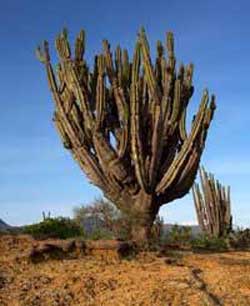How did cactuses evolve?

Neoraimondia herzogiana, a member of the leafless, stem-succulent Cactoideae, growing in central Bolivia. Credit: E.J. Edwards
In a groundbreaking new study in the June issue of American Naturalist, Erika J. Edwards (Yale University and University of California, Santa Barbara) and Michael J. Donoghue (Yale University) explore how leafy, “normal” plants evolved into the leafless succulent cactus.
“The cactus form is often heralded as a striking example of the tight relationship between form and function in plants,” write the authors. “A succulent, long-lived photosynthetic system allows cacti to survive periods of extreme drought while maintaining well-hydrated tissues.”
Recent molecular phylogenetic work has confirmed that Pereskia, a genus that consists of 17 species of leafy shrubs and trees, is where the earliest cactus lineages began. Using field studies and environmental modeling, Edwards and Donoghue found that the Pereskia species already showed water use patterns that are similar to the leafless, stem-succulent cacti.
“[Our] analyses suggest that several key elements of cactus ecological function were established prior to the evolution of the cactus life form,” explain the authors. “Such a sequence may be common in evolution, but it has rarely been documented as few studies have incorporated physiological, ecological, anatomical, and phylogenetic data.”
Media Contact
More Information:
http://www.uchicago.eduAll latest news from the category: Ecology, The Environment and Conservation
This complex theme deals primarily with interactions between organisms and the environmental factors that impact them, but to a greater extent between individual inanimate environmental factors.
innovations-report offers informative reports and articles on topics such as climate protection, landscape conservation, ecological systems, wildlife and nature parks and ecosystem efficiency and balance.
Newest articles

Bringing bio-inspired robots to life
Nebraska researcher Eric Markvicka gets NSF CAREER Award to pursue manufacture of novel materials for soft robotics and stretchable electronics. Engineers are increasingly eager to develop robots that mimic the…

Bella moths use poison to attract mates
Scientists are closer to finding out how. Pyrrolizidine alkaloids are as bitter and toxic as they are hard to pronounce. They’re produced by several different types of plants and are…

AI tool creates ‘synthetic’ images of cells
…for enhanced microscopy analysis. Observing individual cells through microscopes can reveal a range of important cell biological phenomena that frequently play a role in human diseases, but the process of…





















